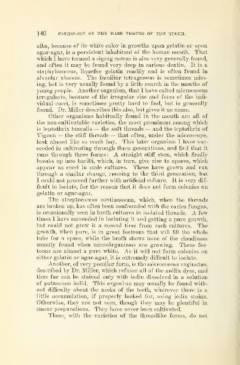Page 360 - My FlipBook
P. 360
140 PATHOLOGY OF THE HARD TISSUES OF THE TEETH.
alba, because of its white color in growths upon gelatin or upon
agar-agar, is a persistent inhabitant of the human mouth. That
which I have termed a zigzag coccus is also very generally found,
and often it may be found very deep in carious dentin. It is a
staphylococcus, liquefies gelatin readily and is often found in
alveolar abscess. The familiar tetragenous is sometimes miss-
ing, but is very usually found by a little search in the mouths of
young people. Another organism, that I have called micrococcus
irregularis, because of the irregular size and foi'm of the indi-
vidual cocci, is sometimes pretty hard to find, but is generally
found. Dr. Miller describes this also, but gives it no name.
Other organisms habitually found in the mouth are all of
the non-cultivatable varieties, the most prominent among which
is leptothrix buccalis — the soft threads — and the leptothrix of
Vignon — the stiff threads — that often, under the microscope,
look almost like so much hay. This later organism I have suc-
ceeded in cultivating through three generations, and find that it
runs through three forms: A straight stiff stem, which finally
breaks up into bacilli, which, in turn, give rise to spores, which
appear as cocci in stale cultures. These have grown and run
through a similar change, running to the third generation, but
I could not proceed further with artificial culture. It is very dif-
ficult to isolate, for the reason that it does not form colonies on
gelatin or agar-agar.
The streptococcus continuosum, which, when the threads
are broken up, has often been confounded with the caries fungus,
is occasionally seen in broth cultures in isolated threads. A few
times I have succeeded in isolating it and getting a pure growth,
but could not grow it a second time from such cultures. The
growth, when pure, is in great festoons that will fill the whole
tube for a space, while the broth shows none of the cloudiness
usually found when microorganisms are growing. These fes-
toons are almost a pure white. As it will not form colonies on
either gelatin or agar-agar, it is extremely difScult to isolate.
Another, of very peculiar form, is the micrococcus vaginatus,
described by Dr. Miller, which refuses all of the anilin dyes, and
thus far can be stained only with iodin dissolved in a solution
of potassium iodid. This organism may usually be found with-
out difficulty about the necks of the teeth, wherever there is a
little accumulation, if properly looked for, using iodin stains.
Otherwise, they are not seen, though they may be plentiful in
smear preparations. They have never been cultivated.
These, with the varieties of the threadlike forms, do not


